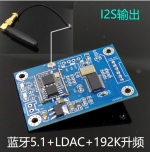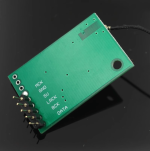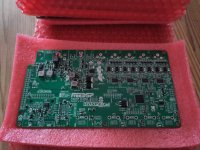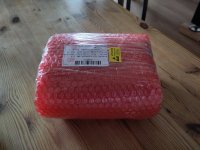Hello,
First of all, thank you, CyberPit-san, for sharing such a great project!
I've been following this thread for a while, there were couple of post mentioning need for 8ch USB input (and maybe output).I understand the current HW limitation of only one I2S input available.
The device also requires USBi for reconfiguration of the DSP. I faced the same issue in my D-class DSP amplifier and found a solution for combining USB-I2S and ADAU configuration from SigmaStudio into one USB interface.
So I'd like to promote my project a bit in this topic since I believe it fits here quite well:
https://www.diyaudio.com/community/threads/audio-transport-module-york.406025/
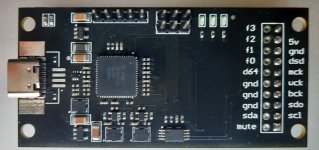
It replaces Amanero module and in basic configuration (PIC32 only, without BT module and ESP32) can add interface for ADAU reconfiguration. As for USB audio it is capable to input/output 2 channels (up to 8 but not in current hardware - only one I2S is routed), 44.1-384kHz. Can be limited to 192k since ADAU can't take more than that.
I'll need maybe a week to polish FW a bit for this and then I can ship one module to you to try it out. Please DM me if you are interested.
Best Regards,
Vladislav
First of all, thank you, CyberPit-san, for sharing such a great project!
I've been following this thread for a while, there were couple of post mentioning need for 8ch USB input (and maybe output).I understand the current HW limitation of only one I2S input available.
The device also requires USBi for reconfiguration of the DSP. I faced the same issue in my D-class DSP amplifier and found a solution for combining USB-I2S and ADAU configuration from SigmaStudio into one USB interface.
So I'd like to promote my project a bit in this topic since I believe it fits here quite well:
https://www.diyaudio.com/community/threads/audio-transport-module-york.406025/

It replaces Amanero module and in basic configuration (PIC32 only, without BT module and ESP32) can add interface for ADAU reconfiguration. As for USB audio it is capable to input/output 2 channels (up to 8 but not in current hardware - only one I2S is routed), 44.1-384kHz. Can be limited to 192k since ADAU can't take more than that.
I'll need maybe a week to polish FW a bit for this and then I can ship one module to you to try it out. Please DM me if you are interested.
Best Regards,
Vladislav
Last edited:
Member
Joined 2018
Hello Vladislav-San,
That's nice information!
FreeUSBi driver is difficult to install...
Genuine Amanrro and USBi are both expensive for DIY hobbyists.
But, Now we'll have many options for configuring the EEPROM.
I am happy to hear about your project information.
CyberPit
That's nice information!
FreeUSBi driver is difficult to install...
Genuine Amanrro and USBi are both expensive for DIY hobbyists.
But, Now we'll have many options for configuring the EEPROM.
I am happy to hear about your project information.
CyberPit
Hello Vladislav,
this looks like a realy nice project.
The ADAU configuration will not work on the octavia though as the I2C bus of the Amanero header is not connected to anything. Nothing that could be changed in the future or with some cables though.
The USB-C plug is also very appealing
I will have a deeper look into your project later on.
BR Ludwig
this looks like a realy nice project.
The ADAU configuration will not work on the octavia though as the I2C bus of the Amanero header is not connected to anything. Nothing that could be changed in the future or with some cables though.
The USB-C plug is also very appealing
I will have a deeper look into your project later on.
BR Ludwig
Hi Ludwig,
That's ok, I don't think the performance difference will be audible to me in my setup. So yes please, let me know how
Now I have an old NAD 7 channel receiver which takes care of the home cinema and for music source there's a raspberry pi/moode and a record player with a tube pre. I then switch over to a tube amp (the one that's not currently in my garage), both which I cannot use when the beamer and its wifi are running :-( still working on that issue...
This board would replace the raspi and give me the option to do some room correction including the analog input. Maybe even with the S/PDIF from the HDMI-to-beamer box, which now goes to the NAD.
Should be fun playing with it in any case.
Best regards
Amir
That's ok, I don't think the performance difference will be audible to me in my setup. So yes please, let me know how
Now I have an old NAD 7 channel receiver which takes care of the home cinema and for music source there's a raspberry pi/moode and a record player with a tube pre. I then switch over to a tube amp (the one that's not currently in my garage), both which I cannot use when the beamer and its wifi are running :-( still working on that issue...
This board would replace the raspi and give me the option to do some room correction including the analog input. Maybe even with the S/PDIF from the HDMI-to-beamer box, which now goes to the NAD.
Should be fun playing with it in any case.
Best regards
Amir
CyberPit,
I will put together couple of pictures, maybe a video for demonstration.
Ludilu,
Indeed, in current hardware it will require 2 wires from the module to USBi connector.
As for USB-C - yes, I found it much more convenient but there is also an option to solder USB-B because many people are used to it.
Thank you!
I will put together couple of pictures, maybe a video for demonstration.
Ludilu,
Indeed, in current hardware it will require 2 wires from the module to USBi connector.
As for USB-C - yes, I found it much more convenient but there is also an option to solder USB-B because many people are used to it.
Thank you!
Member
Joined 2018
Hello eclipsevl-San,
Thank you for your support.
I have now started adding a feature for the "York" I2C programming.

The default routing is RPI.
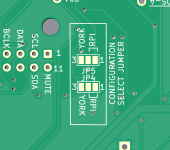
If you want to configure DSP/EEPROM via a York, need to pattern-cut between pin1-2 and make solder jumpers on JP4/JP5 pin2-3.
This York-ready design will be available soon.
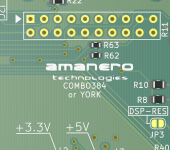
Regards,
CyberPit
Thank you for your support.
I have now started adding a feature for the "York" I2C programming.
The default routing is RPI.

If you want to configure DSP/EEPROM via a York, need to pattern-cut between pin1-2 and make solder jumpers on JP4/JP5 pin2-3.
This York-ready design will be available soon.

Regards,
CyberPit
If you mean the group buy than this is too late. The boards are already manufactured and on the way to me. SryHmmm, should we wait until this change is done? Or will there need to be a lot of testing to verify, and we should just go with the current revision?
Member
Joined 2018
Hi ghfgh-San,
Yes, It's possible.
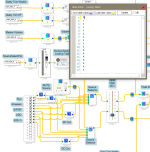
You can grow the algorithm of the Source Selectors by 1.
Then change the top list of the lookup table from 0 to 5.
After changing this, add a hardware switch or something to make the short connection between AUX5 and GND.
Pull AUX5 down to the GND, anytime the source input will change to the I2S input.
If your board has BT connection indicator LED, maybe you can design an automatic switching circuit.
CyberPit
Can the extra I2S interface be used to connect a Bluetooth module? If so, how do I select the Bluetooth input source?
Yes, It's possible.

You can grow the algorithm of the Source Selectors by 1.
Then change the top list of the lookup table from 0 to 5.
After changing this, add a hardware switch or something to make the short connection between AUX5 and GND.
Pull AUX5 down to the GND, anytime the source input will change to the I2S input.
If your board has BT connection indicator LED, maybe you can design an automatic switching circuit.
CyberPit
Small update
I assembled my own board on the weekend to test if everything is working. So far I was able to test SPDIF input, analog input and two balanced outputs.
I also started sorting all the components. I should be able to send out the first 2-3 boards tomorrow.
BR Ludwig
I assembled my own board on the weekend to test if everything is working. So far I was able to test SPDIF input, analog input and two balanced outputs.
I also started sorting all the components. I should be able to send out the first 2-3 boards tomorrow.
BR Ludwig
- Home
- Source & Line
- Digital Line Level
- FreeDSP OCTAVIA
